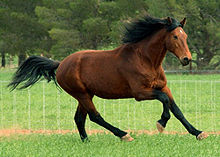 The Cleveland Bay generally stands between 16 and 16.2 hands (64 to 66 inches, 163 to 168 cm), and is always bay in colour. Bright bay horses (bays with a more reddish tint than normal) are the most preferred by breeders, followed by ordinary bay, dark bay and then light bay. This preference for brighter shades of bay was originally stated in the official breed standard, although this stipulation has since been removed. In some bloodlines of the breed, light, grayish hairs in the mane and tail are known as a characteristic of pure blood. White markings, except for a small star on the forehead, render the horse inadmissible to the stud book. Horses are expected to have complete black points, including completely black lower legs. Legs that are red below the knees and hocks are considered faulty in colour, although they do not disqualify a horse from registry. The occasional red legs that appear in the breed are thought to come from chestnut Thoroughbred stallions that were crossed into Cleveland Bay and Yorkshire Coach Horse bloodlines at some points in the history of both breeds. The uniformity in colour is encouraged as it makes creating matching driving teams and pairs very easy. When the breed was first developed, the horses almost always had a countershaded dorsal stripe, but these disappeared with the outcrossings of the 18th century.
The Cleveland Bay generally stands between 16 and 16.2 hands (64 to 66 inches, 163 to 168 cm), and is always bay in colour. Bright bay horses (bays with a more reddish tint than normal) are the most preferred by breeders, followed by ordinary bay, dark bay and then light bay. This preference for brighter shades of bay was originally stated in the official breed standard, although this stipulation has since been removed. In some bloodlines of the breed, light, grayish hairs in the mane and tail are known as a characteristic of pure blood. White markings, except for a small star on the forehead, render the horse inadmissible to the stud book. Horses are expected to have complete black points, including completely black lower legs. Legs that are red below the knees and hocks are considered faulty in colour, although they do not disqualify a horse from registry. The occasional red legs that appear in the breed are thought to come from chestnut Thoroughbred stallions that were crossed into Cleveland Bay and Yorkshire Coach Horse bloodlines at some points in the history of both breeds. The uniformity in colour is encouraged as it makes creating matching driving teams and pairs very easy. When the breed was first developed, the horses almost always had a countershaded dorsal stripe, but these disappeared with the outcrossings of the 18th century.
Partbred Cleveland Bays are sometimes called Cleveland Bay Sporthorses, although they are referred to by the US and UK registries as part breds. They are eligible for registration with the Cleveland Bay Part Bred Registry, but must not be registered with any other registry. To be eligible, horses must have at least one grandparent registered with the main Cleveland Bay Horse Society stud book .The Australasian registry refers to part breds as Sporthorses, although they still require at least 25 percent Cleveland Bay blood.
